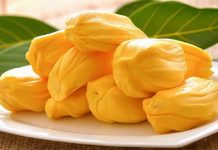Family: Cucurbitaceae
Synonym: Gymnopetalum cochinchinense (Lour.) Kurz, Gymnopetalum chinensis (Lour.) Merr.
Bengali/Vernacular name: Bati jhinga (Bengali), Kainda phol (Chittagong).
Tribal name: Aachoroy (Khumi), Mang-an-kha (Lushai), Tittol gulo (Chakma), Meliotrima (Marma), Ting-tow (Murang), Tobbai-apang (Rakhaing), Haa-eeh-chae (Chak).
Description of the Plant: A perennial, climbing herb. Stem and branches slender, hispid or villous. Tendrils filiform, usually simple. Leaves ovate, 4-8 cm long and as broad, undivided or lobed up to the middle, villose-hirsute, somewhat undulate and minutely denticulate. Plant monoecious. Male flowers: solitary or in raceme of 3-8 flowers, corolla white. Female flowers: solitary, corolla white. Fruits oblong-ovate, orange, 4-5 cm long, smooth, 10-ribbed, acute at both ends.Seeds oblong, compressed, dusky.
Plant parts Used: Leaf, fruit, root.
Traditional
Uses: Paste prepared from the plant is used to
rub the body for the remedy of body pain.
Medicinally
the leaves are used against rheumatism and tetanus, and to cure ophthalmia.
Traditionally, the young fruits
of the plant are generally boiled
and taken, or
the juice obtained after boiling
are taken once a day for the treatment of diabetes, and malaria.
Root paste mixed with hot water is
rubbed on the body in body-ache, and atrophy of limb.
A paste made with the roots of the plant is rubbed on body in body pain,
and pneumonia.
Distribution: This species is common throughout the country.
Is this plant misidentified? If yes, please tell us….















… [Trackback]
[…] Find More Information here on that Topic: natureinfo.com.bd/gymnopetalum-chinense-lour-merr/ […]